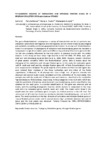Use este identificador para citar ou linkar para este item:
http://www.alice.cnptia.embrapa.br/alice/handle/doc/877017| Título: | Phylogenetic analysis of nodulation and nitrogen fixation genes of a brazilian collection of Bradyrhizobium strains. |
| Autoria: | MENNA, P.  RIBEIRO, R. A.   HUNGRIA, M.   |
| Afiliação: | PAMELA MENNA, CNPq; RENAN A. RIBEIRO, UEL; MARIANGELA HUNGRIA DA CUNHA, CNPSO. |
| Ano de publicação: | 2010 |
| Referência: | In: INTERNATIONAL CONFERENCE ON CULTURE COLLECTIONS, 12., 2010, Florianópolis. Biological Resource Centrers: gateway to biodiversity and services for innovations in biotechnology: proceedings. [S.l]: WFCC, 2010. |
| Conteúdo: | The genus Bradyrhizobium encompasses a variety of bacteria that can live in symbiotic and endophytic associations with legumes and non-legumes, and are characterized by physiological and symbiotic versatility and broad geographical distribution. In studies with Bradyrhizobium strains the comparison of phylogenies of nodulation and housekeeping genes has indicated a monophyletic origin of nodulation genes and diffusion by vertical and horizontal gene transfer, the last one probably influenced by the host plants. In previous studies with the strains analyzed in this study we have shown high diversity in the 16S rRNA, ITS rRNA, atpD, glnII, dnaK and recA housekeeping genes (Menna et al., 2006, 2009). However, despite indications of great genetic variability within the Bradyrhizobium genus, little is known about the phylogeny of the nodulation and nitrogen fixation genes. In this study the nodulation genes nodY/K, nodA and nodZ and the nitrogen fixation gene nifH of forty Bradyrhizobium strains were sequenced and analyzed. The great majority of the strains are from tropical regions and were isolated from members of the three subfamilies and nine tribes of the family Leguminosae (=Fabaceae). In all phylogenetic trees a high level of genetic diversity was observed and several clusters were correlated with the subfamilies of the host plants. One example was with the symbionts of Glycine max and Acacia sp., classified in the subfamilies Papilionoideae and Mimosoideae, respectively. In the phylogenetic trees built with nodY/K and nodA the symbionts of Acacia sp. were clustered in an isolated group, and no amplification was obtained for the nodZ gene. A successful amplification of nifH gene was obtained with all strains, and the resulting phylogenetic tree had similar clusters in comparison to the trees build with the nodulation genes (nodY/K, nodA and nodZ). The strains which failed in the amplification for some nodulation genes occupied an isolated position in the nifH tree. The comparison of all trees has shown no correlation between housekeeping and nod and nifH genes. The results pointed out the high diversity of nodulation and nitrogen fixation genes of tropical Bradyrhizobium strains and in several clusters high correlation between nod and nif genes and the host plants was observed. Partially financed by: CNPq (577933/2008-6; 558455/2008-5; 470162/2009-0) |
| Thesagro: | Fixação de nitrogênio |
| NAL Thesaurus: | Nitrogen fixation |
| Palavras-chave: | Análise filogenética |
| Tipo do material: | Resumo em anais e proceedings |
| Acesso: | openAccess |
| Aparece nas coleções: | Resumo em anais de congresso (CNPSO)  |
Arquivos associados a este item:
| Arquivo | Descrição | Tamanho | Formato | |
|---|---|---|---|---|
| ICCC.12Pamela.pdf | 139,34 kB | Adobe PDF |  Visualizar/Abrir |









